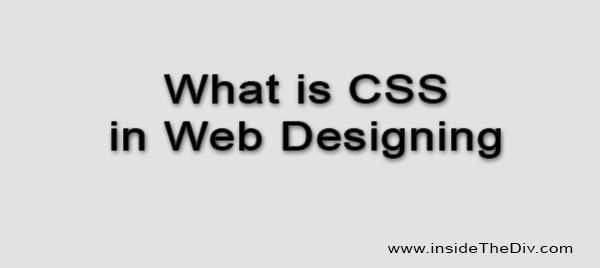What is CSS in web designing with example
Last Updated: 2022-12-16 17:30:30
Cascading Style Sheets (CSS) is a style sheet language used for describing the look and formatting of a document written in HTML. In web design, CSS is used to control the appearance and layout of a website, including font sizes, colors, and the positioning of elements on the page.
Here is an example of how CSS can be used in web design:
Suppose you have an HTML document with the following structure:
< html>
< head>
< title>My Website
< /head>
< body>
< h1>Welcome to my website!
< p>This is a paragraph of text.
< /body>
< /html>
You can use CSS to control the appearance of the text on the page by defining styles for the h1 and p elements.
For example, you might add the following CSS to your website:
h1 {
font-size: 32px;
color: blue;
}
p {
font-size: 16px;
color: black;
}
This CSS code would make the text of the h1 element appear in a blue font that is 32 pixels in size, and the text of the p element appears in a black font that is 16 pixels in size.
CSS can be used to control many aspects of the appearance and layout of a website, including the font, color, size, and position of elements on the page, as well as the responsiveness of the website for different screen sizes.
How CSS works with HTML
CSS works with HTML to style and layout web pages. HTML (Hypertext Markup Language) is a markup language used to structure and organize content on the web. It consists of elements that are represented by tags, which are surrounded by angle brackets. For example, the h1 element is used to represent a heading and is written as < h1>.
CSS is used to control the appearance and layout of the elements on an HTML page. It does this by defining styles for specific HTML elements, or groups of elements, using selectors. These styles can include things like font sizes, colors, and the position of elements on the page.
Here is an example of how CSS can be used with HTML to style and layout a page:
< html>
< head>
< title>My Website
< style>
h1 {
font-size: 32px;
color: blue;
}
p {
font-size: 16px;
color: black;
}
.container {
width: 80%;
margin: 0 auto;
}
< /style>
< /head>
< body>
< div class="container">
< h1>Welcome to my website!
< p>This is a paragraph of text.
< /div>
< /body>
< /html>
In this example, the CSS defines styles for the h1 and p elements, as well as a class called "container". The h1 element will have a blue font that is 32 pixels in size, and the p element will have a black font that is 16 pixels in size. The div element with the "container" class will have a width of 80% of the screen and will be centered on the page by setting the left and right margins to "auto".
This is a simple example of how CSS can be used with HTML to style and layout a web page. In practice, CSS can be used to control many more aspects of the appearance and layout of a website, including the responsiveness of the website for different screen sizes.
Need CSS for responsive design
Responsive design refers to the practice of designing websites that can adapt to different screen sizes and resolutions, so that they look good and are easy to use on a wide range of devices, including desktop computers, laptops, tablets, and smartphones.
CSS (Cascading Style Sheets) is an essential tool for achieving responsive design. It allows web designers to create style rules that can be applied to different devices, or that can be modified based on the size of the screen.
Here is an example of how CSS can be used for responsive design:
/* Style for desktop screens */
@media (min-width: 1200px) {
.container {
width: 80%;
margin: 0 auto;
}
h1 {
font-size: 32px;
color: blue;
}
p {
font-size: 16px;
color: black;
}
}
/* Style for tablet screens */
@media (min-width: 768px) and (max-width: 1199px) {
.container {
width: 90%;
}
h1 {
font-size: 28px;
}
p {
font-size: 14px;
}
}
/* Style for smartphone screens */
@media (max-width: 767px) {
.container {
width: 95%;
}
h1 {
font-size: 24px;
}
p {
font-size: 12px;
}
}
In this example, the CSS defines different styles for different screen sizes using media queries. The media queries specify the minimum and maximum widths of the screen, in pixels, for which the styles should be applied.
For example, the styles within the first media query will be applied to screens with a minimum width of 1200 pixels, which would include most desktop computers. The styles within the second media query will be applied to screens with a minimum width of 768 pixels and a maximum width of 1199 pixels, which would include most tablets. And the styles within the third media query will be applied to screens with a maximum width of 767 pixels, which would include most smartphones.
By using media queries and CSS, web designers can create websites that look and work well on a wide range of devices. This is especially important in today's world, where people use a variety of devices to access the web.
Some resources for learning more about CSS in web design
There are many resources available for learning more about CSS in web design. Here are a few options:
- Online tutorials and courses: There are many websites and platforms that offer tutorials and courses on CSS and web design. Some popular options include Codecademy, Udemy, and Coursera. These resources typically provide step-by-step instructions and interactive exercises to help you learn the basics of CSS and how to use it in web design.
- Books: There are many books available on CSS and web design, ranging from beginner to advanced levels. Some popular options include "CSS: The Missing Manual" by David Sawyer McFarland and "CSS Secrets" by Lea Verou. Books can be a helpful resource for learning about CSS because they often provide in-depth explanations and examples, as well as practical tips and best practices.
- Online documentation and references: The official documentation and references for CSS are excellent resources for learning about the language and its features. The main CSS documentation is provided by the World Wide Web Consortium (W3C), and it includes a detailed specification of the language as well as examples and explanations of how to use it. Other websites, such as MDN Web Docs, also provide documentation and references for CSS. These resources are especially helpful when you need to look up specific details or want to learn about advanced features of CSS.
- Online communities and forums: There are many online communities and forums where web designers and developers discuss CSS and other web development topics. Some popular options include Stack Overflow and Reddit's /r/webdev subreddit. These communities can be great places to ask questions, get help with problems, and learn from other experienced designers and developers.
- Practice: As with any skill, the best way to learn CSS is to practice using it. You can start by building your own websites or by experimenting with existing HTML and CSS code. This will give you the opportunity to try out different techniques and see how they work in different situations. You can also find practice exercises and projects online or create your own challenges to help you learn and improve your skills.
Still you face problems, feel free to contact with me, I will try my best to help you.

